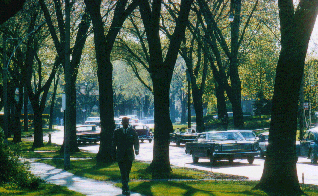
There are many reasons trees are important to city dwellers. There are matters of aesthetics and the spirit, but there are social and economic values. Toronto is a city of trees. More than three million trees dominate our ravines, line our boulevards and beautify our parks. Millions more trees are located on private property. Trees are the lifelines of our city. Trees beautify neighbourhoods. Trees soften the harsh texture of concrete buildings. Trees offer privacy screens, protect people from the sun’s burning rays, and absorb harmful gases, and other pollutants. Trees provide a natural habitat for birds and wildlife, protect soils from erosion, cool streets and homes in the summer, and protect us from winds in the winter. One study in Chicago, found economic savings of up to 40% from the cooling effects of trees in urban situations. The cooling comes in part from shading, but transpiration also contributes significantly. Of particular note are the many fine old White and Red Oaks along the streets and in the back yards of neighbour-hoods such as Deer Park.

In 1998, the writer counted 80 species of trees in the Deer Park area (7 maples 5 pines 5 locusts 5 oaks 3 spruces). Half of these species were introduced, which shows one of the influences of cities on species diversity. In fact if number of species was the answer to diversity, our cities would come out “smelling of roses.” But this is only part of the story; genetic diversity and strength within species, is as important as number of species and planted exotic species tend to be limited to named cultivars which may be clones of a few individual trees. Also there was, and still is, a species imbalance; for example of the over 90,000 street trees on the streets of old Toronto, approximately half were maples and these mostly Norway Maple, 7,000 were Silver Maple and only 1900 Sugar Maple. ; 4300 spruce (largely Colorado); and 4700 others.
Toronto’s Tree Policy
It is useful to examine the City’s urban tree program. Toronto’s trees along city streets, in parks, ravines and natural areas, in the front and back yards of homes, and in landscaped open spaces are collectively known as the city’s “urban forest” and are under the care of Toronto’s Urban Forestry Services. The staff of this unit include certified arborists, professional foresters and many other staff with the experience and training required to protect and grow our urban forest as a natural legacy for all. This program is backed up by several important urban forestry by-laws which regulate the injury and destruction of trees on both City and privately owned land, including:
City Street Tree By-law (Article II of Chapter 813)
A major responsibility of Urban Forestry Services is the maintenance of City owned trees, particularly trees that grow on the City road allowance and in parks. There are approximately 500,000 City owned street trees and 2.5 million trees in parks, ravines and natural areas. Trees are routinely removed due to old age, poor health, hazardous condition, or other problems. These are replaced where ever possible and thousands more trees are planted each year. Locations for planting new trees throughout the City are being looked for actively.
Private Tree By-law (Article III of Chapter 813)
Those trees, which grow on private property in Toronto, are an important part of the urban forest, protected by Urban Forestry Services. Toronto City Council enacted a City-wide By-law to protect trees situated on private property. This by-law regulates injury or removal of privately owned trees which measure 30 cm in diameter or more as measured at 1.4 m above ground level. Property owners are encouraged to protect other healthy trees on their property and keep them green and healthy.
Ravine Protection By-law
Toronto has many ravine areas on both private and public land. Working in co- operation with agencies such as the Toronto Region Conservation Authority the City enforces ravine protection by-laws and limit development proposals in and adjacent to ravine areas. It also works with community groups to restore native species and forest cover to areas currently denuded.
Filling and Grading By-laws and Building Regulations are also used to protect Toronto’s trees. For more information on the City’s policy go to www.toronto.ca/trees/city_trees
The city plants trees on public land (street rights of way, parks and natural areas.) For planting assistance in private property, there are non-profit groups such as LEAF (Local Enhancement and Appreciation of Forests) LEAF offers Toronto residents subsidized backyard tree planting, including on-site advice, a native tree and a planting service. Contact LEAF at 416-413-9244. LEAF also has a website. http://yourleaf.org
1000 Trees in North Toronto
The North Toronto Green Community together with Fairlawn Heights United Church and Neighbourhood Centre, LEAF, The Clean Air Foundation, and The City of Toronto, decided that 1000 Trees and Shrubs should be planted in North Toronto by 2005. You could help by:
- Deciding to plant a tree or shrub in either your front or backyard.
- Calling the North Toronto Green Community at 416-781-7663 for more information or visit website www.ntgc.ca.
- Helping us spread the word, telling all your friends and becoming a volunteer.
